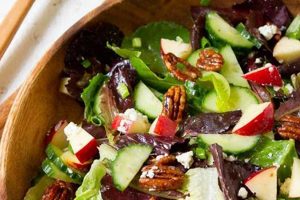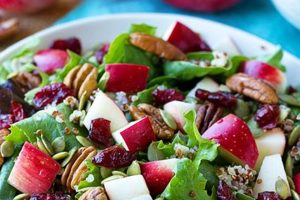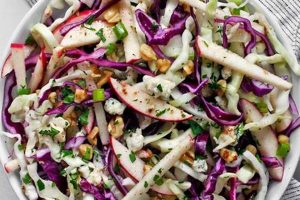Fruit salads featuring a combination of apples and pears offer a refreshing and nutritious dish. These salads can range from simple combinations of sliced fruit to more complex preparations incorporating various cheeses, nuts, dressings, and other complementary ingredients. For example, a basic version might include crisp apples and pears tossed with a light vinaigrette, while a more elaborate recipe could involve crumbled blue cheese, candied walnuts, and a honey-lemon dressing.
The pairing of apples and pears in salads provides a balance of flavors and textures. The sweetness of pears complements the tartness of apples, creating a harmonious taste profile. Furthermore, the varying textures, from the crispness of apples to the softer, juicier nature of pears, add a delightful complexity to each bite. Historically, fruit salads have been appreciated for their simplicity and nutritional value, offering a readily available source of vitamins and fiber. Their adaptable nature makes them suitable for various occasions, from casual lunches to elegant gatherings.
This exploration will delve further into the diverse world of these fruit salads, examining popular varieties, nutritional benefits, preparation techniques, and creative serving suggestions.
Tips for Creating Exceptional Apple and Pear Salads
Achieving a well-balanced and flavorful fruit salad requires attention to detail and a thoughtful selection of ingredients. The following tips offer guidance for creating exceptional combinations.
Tip 1: Select the Right Varieties: Opt for firm, crisp apples such as Honeycrisp, Pink Lady, or Granny Smith. For pears, consider varieties like Bartlett, Bosc, or Anjou. The contrasting textures and sweetness levels will enhance the overall flavor profile.
Tip 2: Prevent Browning: To maintain the appealing appearance of sliced apples and pears, toss them with a small amount of lemon juice or ascorbic acid powder. This helps prevent enzymatic browning.
Tip 3: Balance Flavors: Consider incorporating contrasting flavor elements. Sharp cheeses, such as blue cheese or Roquefort, can complement the sweetness of the fruit. Nuts like walnuts or pecans add a satisfying crunch and earthy notes.
Tip 4: Enhance with Herbs: Fresh herbs can elevate the salad’s complexity. Mint, tarragon, or even a sprinkle of chopped chives can introduce intriguing aromatic dimensions.
Tip 5: Dress Strategically: A simple vinaigrette made with olive oil, lemon juice, and a touch of honey complements the fruit beautifully. Avoid heavy, creamy dressings that can overpower the delicate flavors.
Tip 6: Consider Seasonal Ingredients: Enhance the salad with seasonal additions. During the fall, roasted butternut squash or pomegranate seeds can add a festive touch. In spring, fresh berries provide a burst of color and flavor.
Tip 7: Serve Chilled: Allow the salad to chill slightly before serving. This enhances the crispness of the ingredients and intensifies the flavors.
By following these suggestions, one can create a fruit salad that is not only visually appealing but also offers a delightful balance of textures, flavors, and nutritional benefits.
These tips provide a foundation for creating a variety of apple and pear salad combinations, allowing for experimentation and customization based on individual preferences and seasonal availability.
1. Ingredient Selection
Ingredient selection forms the foundation of successful apple and pear salad recipes. Careful consideration of each component contributes to the overall flavor, texture, and visual appeal of the final dish. Strategic choices transform simple ingredients into a harmonious and satisfying culinary experience.
- Apple Variety
The choice of apple variety significantly impacts the salad’s flavor profile. Tart apples like Granny Smith provide a sharp counterpoint to the sweetness of pears and other ingredients, while sweeter varieties like Honeycrisp or Fuji offer a milder, more delicate flavor. Selecting a mix of apple varieties can create a more complex and balanced taste experience.
- Pear Variety
Similar to apples, pear varieties offer diverse flavors and textures. Bartlett pears contribute a classic, juicy sweetness, while Bosc pears provide a firmer texture and slightly spicier notes. Anjou pears offer a mild, buttery flavor that complements various cheeses and nuts.
- Complementary Ingredients
Beyond apples and pears, a range of ingredients can enhance the salad. Cheeses like crumbled blue cheese, Gorgonzola, or feta add salty, tangy notes and creamy textures. Nuts such as walnuts, pecans, or almonds provide crunch and earthy flavors. Dried fruits like cranberries or raisins introduce sweetness and chewiness.
- Dressing Selection
The dressing plays a critical role in unifying the salad’s flavors. Light vinaigrettes made with olive oil, lemon juice, or balsamic vinegar complement the delicate flavors of the fruit. Adding a touch of honey or maple syrup can balance tartness and enhance sweetness. Avoid heavy, creamy dressings that may overpower the subtle fruit flavors.
The interplay of these ingredient choices determines the final character of the apple and pear salad. Thoughtful selection ensures a harmonious balance of flavors, textures, and visual appeal, elevating the dish beyond a simple combination of fruits to a complex and satisfying culinary creation.
2. Flavor Balancing
Flavor balancing is crucial in crafting exceptional apple and pear salads. A successful salad transcends a mere combination of ingredients; it represents a harmonious blend of contrasting yet complementary flavors. This balance elevates the sensory experience, transforming a simple dish into a complex and satisfying culinary creation.
- Sweetness vs. Tartness
The inherent sweetness of pears requires a counterpoint. Tart apples, such as Granny Smith, provide this balance. Incorporating acidic elements like lemon juice in the dressing further enhances this interplay. The dynamic between sweet and tart creates a refreshing and palate-cleansing effect.
- Creaminess vs. Crispness
Textural contrast contributes to flavor balancing. The crispness of apples and pears benefits from the addition of creamy elements like soft cheeses (e.g., brie, goat cheese) or a sprinkle of crumbled blue cheese. This interplay of textures adds depth and prevents the salad from becoming monotonous.
- Earthiness vs. Brightness
Earthy notes from ingredients like walnuts, pecans, or toasted hazelnuts complement the bright, fresh flavors of the fruit. These additions provide depth and complexity, preventing the salad from tasting overly sweet or one-dimensional. A sprinkle of fresh herbs, such as mint or tarragon, can further amplify the bright notes.
- Sharpness vs. Mildness
Incorporating sharp flavors, such as those found in aged cheddar or Roquefort cheese, creates a compelling contrast to the mild sweetness of the pears and some apple varieties. This contrast adds intrigue and prevents the salad from becoming bland. The sharp notes cut through the sweetness, creating a more balanced and nuanced flavor profile.
Mastering flavor balancing elevates apple and pear salads from simple to exceptional. The interplay of these contrasting yet complementary flavors creates a dynamic and engaging culinary experience, ensuring each bite offers a delightful combination of tastes and textures.
3. Texture Contrast
Texture contrast significantly contributes to the sensory appeal of apple and pear salads. The inherent textures of apples and pearsranging from the crisp bite of a Honeycrisp apple to the smooth, buttery texture of a ripe Anjou pearoffer a foundational textural complexity. However, strategic incorporation of additional ingredients elevates this contrast, transforming a simple fruit salad into a multi-dimensional culinary experience. This contrast stimulates multiple sensory receptors in the mouth, enhancing enjoyment and satisfaction.
Consider the addition of nuts. The crunch of walnuts or pecans juxtaposes the softer textures of the fruit, introducing a pleasurable textural interplay. Similarly, incorporating dried cranberries or raisins provides a chewy element, further diversifying the mouthfeel. Crumbled cheeses, such as feta or blue cheese, contribute creamy textures, contrasting with the crispness of the fruit and the potential crunch of nuts. Even the choice of dressing can influence texture. A light vinaigrette offers a smooth counterpoint, while a honey-mustard dressing can introduce a subtle textural variation.
The practical significance of understanding texture contrast lies in the ability to create more engaging and satisfying salads. A salad dominated by similar textures, regardless of flavor complexity, risks becoming monotonous. Thoughtful incorporation of contrasting textures ensures each bite offers a dynamic interplay of sensations, enhancing enjoyment and promoting a more complete sensory experience. Achieving this balance requires consideration of ingredient choices and their inherent textural properties, ultimately leading to a more sophisticated and enjoyable culinary creation. This principle extends beyond mere enjoyment, impacting perceived freshness and quality.
4. Presentation Techniques
Presentation techniques significantly influence the perceived quality and enjoyment of apple and pear salads. While flavor and texture remain paramount, visual appeal enhances the dining experience. Effective presentation elevates a simple salad from a basic dish to a visually engaging culinary creation. This connection between presentation and enjoyment stems from the psychological impact of visual stimuli on appetite and perceived freshness. A well-presented salad stimulates anticipation and enhances the overall sensory experience.
Consider the arrangement of ingredients. A tossed salad, while convenient, often lacks visual interest. Alternatively, arranging sliced apples and pears in an overlapping pattern on a platter creates a more appealing presentation. Incorporating height, through elements like a mound of crumbled cheese or strategically placed sprigs of fresh herbs, adds visual dimension. Color contrast also plays a crucial role. The green and yellow hues of apples and pears benefit from the inclusion of contrasting colors, such as the deep red of pomegranate seeds or the vibrant orange of dried apricots. Even the choice of serving vessel contributes to the overall presentation. A rustic wooden bowl conveys a different aesthetic than a sleek, modern platter.
The practical application of these techniques extends beyond aesthetic considerations. Careful presentation can also enhance the perceived freshness and quality of the salad. For instance, ensuring that sliced fruit remains free from browning, through techniques like a light lemon juice coating, contributes to a more appetizing appearance. Attention to detail, such as removing bruised or damaged pieces of fruit, further reinforces the impression of care and quality. Ultimately, effective presentation enhances the perceived value of the salad, transforming it from a simple combination of ingredients into a carefully crafted culinary composition.
5. Dressing Choices
Dressing choices profoundly influence the overall flavor profile and balance of apple and pear salads. The dressing acts as a unifying element, binding the individual ingredients and creating a cohesive culinary experience. Careful consideration of dressing selection ensures that the delicate flavors of the fruit are complemented, not masked. An overly assertive dressing can overwhelm the subtle sweetness and tartness of apples and pears, while a bland dressing fails to enhance the salad’s inherent flavors. The interplay between dressing and ingredients creates a synergistic effect, where the whole becomes greater than the sum of its parts. For example, a light vinaigrette made with extra virgin olive oil, lemon juice, and a touch of Dijon mustard provides a bright, acidic counterpoint to the sweetness of the fruit, while a creamy dressing based on Greek yogurt and honey adds a richer, more decadent dimension.
The practical significance of understanding dressing choices lies in the ability to tailor the salad’s flavor profile to specific preferences and occasions. A light vinaigrette suits a refreshing summer salad, while a richer dressing complements a more substantial autumnal offering. Furthermore, specific ingredients within the salad may influence dressing selection. A salad incorporating strong cheeses, such as blue cheese or Roquefort, benefits from a robust dressing that can stand up to the assertive flavors, whereas a salad featuring delicate herbs and nuts requires a lighter touch. The viscosity of the dressing also impacts the overall experience. A thinner vinaigrette coats the ingredients lightly, allowing their individual flavors to shine through, while a thicker dressing clings more heavily, creating a more substantial and cohesive flavor profile. The choice hinges on the desired balance and overall culinary objective.
Ultimately, successful dressing choices enhance the sensory experience of apple and pear salads. They provide a crucial bridge between individual ingredients, creating a harmonious blend of flavors and textures. Careful consideration of acidity, sweetness, richness, and viscosity allows for customization and ensures that the final dish achieves the desired balance and complexity. This understanding empowers culinary creativity, enabling the creation of salads tailored to specific palates and occasions. The interplay between dressing and ingredients represents a fundamental principle in achieving a balanced and satisfying culinary experience.
Frequently Asked Questions
This section addresses common inquiries regarding apple and pear salad recipes, offering practical guidance for optimal preparation and enjoyment.
Question 1: How can enzymatic browning of apples and pears be prevented?
Enzymatic browning, a natural oxidation process, can be minimized by coating cut surfaces with an acidic agent. Lemon juice, a readily available option, effectively inhibits browning. Alternatively, a solution of ascorbic acid (vitamin C) and water provides similar protection. Submerging cut fruit in a bowl of cold water with a splash of lemon juice also helps prevent discoloration. These methods maintain the fruit’s appealing appearance without significantly altering the flavor profile.
Question 2: What are optimal apple and pear varieties for salads?
Firm, crisp apple varieties, such as Honeycrisp, Pink Lady, or Granny Smith, contribute desirable texture and flavor. For pears, Bartlett, Bosc, or Anjou varieties offer a balance of sweetness and firmness. Selecting varieties with contrasting textures and sweetness levels enhances the salad’s complexity.
Question 3: How can one enhance the flavor profile of an apple and pear salad?
Incorporating complementary ingredients elevates the flavor profile. Sharp cheeses, such as blue cheese or Roquefort, offer a salty, tangy counterpoint to the fruit’s sweetness. Nuts, including walnuts or pecans, provide textural contrast and earthy notes. Dried fruits, like cranberries or raisins, add sweetness and chewiness. Fresh herbs, such as mint or tarragon, introduce aromatic complexity.
Question 4: What dressings best complement apple and pear salads?
Light vinaigrettes, typically made with olive oil, lemon juice, or balsamic vinegar, complement the delicate flavors of apples and pears without overpowering them. A touch of honey or maple syrup can balance tartness. Heavy, creamy dressings should generally be avoided, as they can mask the fruit’s subtle flavors.
Question 5: How can apple and pear salads be stored to maintain freshness?
Proper storage maintains optimal freshness and flavor. Storing prepared salad in an airtight container in the refrigerator minimizes oxidation and preserves texture. Ideally, salads should be consumed within a day or two of preparation for optimal quality. Keeping dressing separate until serving further extends freshness.
Question 6: Can apple and pear salads be adapted for different seasons?
Seasonal variations offer opportunities for creative adaptations. In autumn, incorporating roasted butternut squash or pomegranate seeds adds warmth and seasonal flavors. During spring, fresh berries or edible flowers introduce vibrancy and lightness. Adapting ingredient choices to seasonal availability ensures optimal flavor and freshness throughout the year.
Understanding these frequently asked questions facilitates confident preparation of flavorful and appealing apple and pear salads. Careful attention to ingredient selection, dressing choices, and storage methods ensures a satisfying culinary experience.
This concludes the frequently asked questions section. The following segment will explore variations on the classic apple and pear salad theme.
Apple and Pear Salad Recipes
Exploration of apple and pear salad recipes reveals a versatile culinary canvas. Careful ingredient selection, balancing contrasting flavors and textures, and thoughtful presentation elevate these salads beyond simple fruit combinations. Acidity, sweetness, creaminess, and crispness intertwine to create a dynamic sensory experience. Strategic dressing choices further enhance flavor profiles, unifying diverse elements into a cohesive whole. Adaptability to seasonal ingredients allows for year-round enjoyment, showcasing the inherent versatility of these salads.
The potential of apple and pear salad recipes extends beyond basic nutrition. Culinary innovation transforms readily available ingredients into sophisticated and satisfying dishes. Continued exploration of flavor combinations and presentation techniques promises further evolution, enriching culinary experiences and highlighting the enduring appeal of fresh, seasonal cuisine.






